Is free will measurable? This article delves into neuroscientific and psychological perspectives on decision-making, exploring whether biometric tools like EEG, eye-tracking, and reaction time analysis can quantify human autonomy. Discover key research findings and debates on whether free will is an illusion or a fundamental part of cognition.
Table of Contents
One of the prevailing questions of human existence, is what is, and can you measure free will? When you concern yourself with the nature of human behavior on a philosophical level, then at some point in time the question of how much of our behavior is predetermined will pop up.
Are our actions chaotic and random manifestations of exact moments in time – with no ties to any point in the past – or are they the conclusions of an ever-evolving chain of decisions and actions? In short – is there a scientific way of proving or disproving free will through measurement?
What Is Free Will?
The definition of free will, condensed to the point of custard, is that a person is free to take whatever course of action they want without interference or influence.
Philosophy, famously vague as ever, has arrived at the consensus that we both do and do not have free will. That is to say, we are acting as free agents in the world at any given time, but our agency is determined, not predetermined, by the entirety of our previous actions.

So, Can You Measure Free Will?
As many people might rightfully claim, trying to logically prove or disprove free will from philosophizing alone might be a little redundant and fairly pointless – at least in terms of getting tangible results. Luckily, however, researchers throughout modern history have tried to find answers to this exact question.
What is arguably the most famous study was developed and carried out by neuroscientist Benjamin Libet in the 1980s. Libet wanted to test if the brain’s “readiness potential” (often just referred to as RP), could be used to determine whether humans have free will or not.
The brain’s “readiness potential”, or Bereitschaftspotential in German, is the term used to describe the measure of activity in the motor cortex and the supplementary motor area of the brain, leading up to voluntary movement. “Readiness Potential” was first described by the German neurophysicists Hans Helmut Kornhuber and Lüder Deecke in 1965.
Libet’s study setup was simple yet elegant; Libet asked each participant to flick their wrists upwards at a random moment, whenever they felt like doing it – that was all. But first, he asked each of them to watch a dot rapidly going around a clockface, and after a full circle, he asked participants to note the position of the dot, as soon as they made the decision to flick their wrists. This time indication technique is now known as “Libet’s W Time”.
During the experiment, Libet would measure participants’ brain activity, using an EEG headset, and focus on the build-up of intent, which is the brain’s readiness potential.

What Libet discovered was that preceding every random flick of a wrist, the brain had a split second of activity leading up to the brain’s decision to flick. Across the respondent pool, there was a rise in brain activity by 0.35 – 0.2 seconds before they consciously decided to move their hands.
Libet took this as proof that free will was not possible. If nonconscious brain activity occurs before conscious awareness, the decision can’t be consciously or freely made. To act freely, our decisions need to take place within the conscious realm – this didn’t seem to be what was happening.
Are we there yet?
And that is that then, it seems. Indeed if the build-up towards an act of free will happens subconsciously, instinctively even, then those measly 0.35 seconds determine that we do in fact not have free will. Or do they?
Since Libet’s groundbreaking experiment, which was made on the premise of the brain’s readiness potential, scientists have looked closely at his findings. Specifically, the premise of the readiness potential and the resulting subjectively “spontaneous voluntary movements” (SVMs) have been the subject of scrutiny.
In 2016, scientists came to the conclusion that what we know about the readiness potential and SVM might not be true after all. In fact, the third of a second leading up to an action (Libet’s V time) was more likely the result of the ebb and flow of background neural noise of the brain, and not the nonconscious brain preparing to jump into action.
This was discovered through a recreation of Libet’s experiment, with an extra step added. Aside from using a button that the respondent should press, instead of a flick of the wrist, the experiments were almost identical. The extra step was that the scientists included a “click” sound to be played randomly. When the respondent heard this stochastic “click” they should press the button as fast as they could. Through the EEG data, the researchers could find no evidence that the readiness potential between the different tasks differed enough to justify attributing that to a specifically focused build-up in the brain.

The answer is maybe: maybe.
What does this mean for free will? Well, on the one hand, we have Libet concluding that free will is impossible because our brain keeps the build-up to action away from our conscious minds – the decision is untouchable. On the other hand, that notion appears to be debunked by the fact that our brains might not be trying to hide anything from us after all – they’re just noisy.
To make it all even more confusing, there is even another annoying philosophical question to address: Does it even make sense to talk about free will if someone is prompted to prepare for specific actions in an experimental setting? Can we ever make a framework to study consciousness when consciousness itself is defined by a lack of framework?
So the question remains; can you measure free will? Who knows, but we should certainly keep trying to come up with ways to try.
What do you think? Do you feel in control?
References:
Kornhuber, H. H., and Deecke, L. (1965). Hirnpotentialänderungen bei Willkürbewe-gungen und passiven bewegungen des menschen: bereitschaftspotential undreafferente Potentiale. Pflügers Arch. EJP 284, 1–17. doi: 10.1007/bf00412364
Libet, B., Gleason, C. A., Wright, E. W., and Pearl, D. K. (1983). Time of conscious intention to act in relation to onset of cerebral activities (readiness-potential): the unconscious initiation of a freely voluntary act. Brain 106, 623–642. doi: 10.1093/brain/106.3.623
Schurger, A., Mylopoulos, M., and Rosenthal, D. (2016). Neural antecedents of spontaneous voluntary movement: a new perspective. Trends Cogn. Sci. 20, 77–79. Doi: 10.1016/j.tics.2015.11.003











